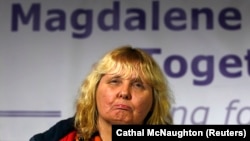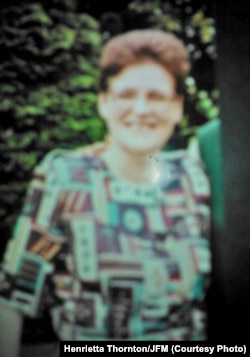Ireland’s Labor Party is calling this week for an official apology and compensation for survivors of the so-called Magdalene Laundries, workhouses run by Roman Catholic nuns through most of the past century.
For years, the government insisted that the workhouses were privately run by the Church. But last week, the government officially admitted its role in sending thousands of girls and young women into the laundries, where they worked in virtual servitude.
Survivors of the workhouses are not satisfied. They say the government failed to offer the official apology and compensation the women say they deserve.
In June 2011, the advocacy group Justice for Magdalenes (JFM) appealed to the United Nations Committee Against Torture, which subsequently called on Ireland to investigate the issue. Last week, Ireland issued the findings of its probe, which showed that Irish governments not only admitted girls to the program, but held lucrative contracts with the laundries. Ireland’s Prime Minister, Enda Kenny, said last Tuesday he is sorry for women forced to live in what he termed a “hostile and far-off environment.”
Mari T. Steed is a JFM co-founder and Committee Director and herself a daughter of a laundry survivor. She calls Kenny’s statement a “farce.”
“Obviously, we were very disappointed. It was perhaps an expression of Kenny's personal ‘remorse,’ but certainly not a full, formal state apology,” she said.
“We spoke to all the survivors and my mum over the past week, and of course they are very disappointed and minced no words about Kenny,” Steed said. “But they are so trusting in the process and us, they feel we will fight it to the end -- and we will.”
Background
The first of the “Magdalene Asylums” were established in the late 1700s to reform “penitent prostitutes,” who took in washing and sewing to pay for their keep. The model quickly spread elsewhere in the United Kingdom, Canada and the United States. By the 19th Century, most of these asylums had closed -- but not in Ireland.
By the 20th Century, the Irish laundries had become workhouses for unwed mothers, orphans, the mentally disabled, the homeless -- and even girls the clergy judged to at risk of getting into trouble because they were too pretty. Today, the term “Magdalene” is still associated with prostitution, which Steed says gives survivors a deep sense of shame.
“The societal connotation has been that these institutions were for women who were prostitutes, criminals or insane,” Steed said. “It was only recently that the public began to learn that there were girls and women in there merely for the "crime" of being pretty, that is, a moral danger to society.”
More than 11,000 women passed through 10 institutions between 1922 and 1996 operated by four religious orders: The Sisters of Our Lady of Charity of Refuge; Congregation of the Sisters of Mercy; Religious Sisters of Charity; and Sisters of the Good Shepherd. The last laundry workhouse was shut down in 1996.
The government report estimates there are between 800 and 1,200 survivors are still living. But because records from two laundries are still missing, Steed believes as many as 2,000 to 3,000 are still alive.
Life in a workhouse
“When she was two years and four months old, she and some of her other siblings were taken away from her father for neglect...into a system called ‘Industrial Schools,’ which were orphanages-slash-reform homes for children.”
Hunting rats
Thornton said even small children were given work to do. “One of their first jobs in the morning was to kill the rats in the kitchen. Starting at five years old, she was making breakfast for 70 girls,” Thornton said.
When Henrietta and her twin were in their early 20s, they grew curious about their past. A social worker eventually found their mother. That’s when the twin learned she was a Magdalene, still living in the convent after decades. They also found out she was “mentally disabled.”
“When Margaret was 13 her IQ was assessed as 50,” Thornton said. “It seems to me that the assessment concluded she was fit for work but unfit for an education. The assessment just determined Margaret was eligible to be a slave.”
At 16, Margaret was transferred to the Gloucester Street Laundry in Dublin, where she would live out her days.
“I think there’s a misconception here that these girls were washing a few blouses for the nuns or something like that,” Thornton said. “It wasn’t nuns’ clothes. It was a factory situation, where they were doing laundry for prisons, the armed forces and other public and private organizations. It was really a big business.”
Brief Reunion
Henrietta and her twin were reunited with their mother in 1995. They met at a hotel café, where Margaret, then 41 years old, sipped her first cup of coffee.
“I learned afterwards that up to when she heard about the possibility of meeting us, she didn’t remember that she had children,” Thornton said. “She had just blocked it from her mind.”
Henrietta Thornton visited Margaret in the High Park convent several times over the next few years. Margaret died in 2003 of Goodpasture Syndrome, a disease caused by exposure to industrial chemicals. Thornton says no one called to tell her about her mother’s death; she heard about the “death of the youngest Magdalene” on the radio.
Full Redress
Survivors are not only looking for a full apology, but lost wages, pensions and health and housing services for the work they performed for the state -- in some cases, for decades.
The Dáil Eireann -- Ireland’s main house of parliament -- will debate the issue this week.
Only one religious order, the Sisters of Charity, has apologized “unreservedly to any woman who experienced hurt” while in their care. The other three orders have issued statements of regret on their websites.
VOA requested an interview with the Irish Catholic Bishops Conference, which did not respond.
For years, the government insisted that the workhouses were privately run by the Church. But last week, the government officially admitted its role in sending thousands of girls and young women into the laundries, where they worked in virtual servitude.
Survivors of the workhouses are not satisfied. They say the government failed to offer the official apology and compensation the women say they deserve.
In June 2011, the advocacy group Justice for Magdalenes (JFM) appealed to the United Nations Committee Against Torture, which subsequently called on Ireland to investigate the issue. Last week, Ireland issued the findings of its probe, which showed that Irish governments not only admitted girls to the program, but held lucrative contracts with the laundries. Ireland’s Prime Minister, Enda Kenny, said last Tuesday he is sorry for women forced to live in what he termed a “hostile and far-off environment.”
Mari T. Steed is a JFM co-founder and Committee Director and herself a daughter of a laundry survivor. She calls Kenny’s statement a “farce.”
“Obviously, we were very disappointed. It was perhaps an expression of Kenny's personal ‘remorse,’ but certainly not a full, formal state apology,” she said.
“We spoke to all the survivors and my mum over the past week, and of course they are very disappointed and minced no words about Kenny,” Steed said. “But they are so trusting in the process and us, they feel we will fight it to the end -- and we will.”
Background
The first of the “Magdalene Asylums” were established in the late 1700s to reform “penitent prostitutes,” who took in washing and sewing to pay for their keep. The model quickly spread elsewhere in the United Kingdom, Canada and the United States. By the 19th Century, most of these asylums had closed -- but not in Ireland.
By the 20th Century, the Irish laundries had become workhouses for unwed mothers, orphans, the mentally disabled, the homeless -- and even girls the clergy judged to at risk of getting into trouble because they were too pretty. Today, the term “Magdalene” is still associated with prostitution, which Steed says gives survivors a deep sense of shame.
“The societal connotation has been that these institutions were for women who were prostitutes, criminals or insane,” Steed said. “It was only recently that the public began to learn that there were girls and women in there merely for the "crime" of being pretty, that is, a moral danger to society.”
More than 11,000 women passed through 10 institutions between 1922 and 1996 operated by four religious orders: The Sisters of Our Lady of Charity of Refuge; Congregation of the Sisters of Mercy; Religious Sisters of Charity; and Sisters of the Good Shepherd. The last laundry workhouse was shut down in 1996.
The government report estimates there are between 800 and 1,200 survivors are still living. But because records from two laundries are still missing, Steed believes as many as 2,000 to 3,000 are still alive.
Life in a workhouse
On entrance into a Magdalene Laundry, girls gave up their given names and were assigned new names or numbers. Survivors tell stories of long hours washing heavy laundry and ironing. They were fed little and allowed to bathe only weekly. If they tried to escape, they were hunted down by police and returned to face solitary confinement, public shaming, whippings or food deprivation.
One such woman was Margaret Bullen — known as No. 322 — who spent 35 years in a Magdalene Laundry. As a teenager, she became pregnant and gave birth to twin daughters. The babies were taken from her and adopted out to an Irish family in the U.S. One of her twins, New York resident Henrietta Thornton, tells VOA her story:
“When she was two years and four months old, she and some of her other siblings were taken away from her father for neglect...into a system called ‘Industrial Schools,’ which were orphanages-slash-reform homes for children.”
Hunting rats
Thornton said even small children were given work to do. “One of their first jobs in the morning was to kill the rats in the kitchen. Starting at five years old, she was making breakfast for 70 girls,” Thornton said.
When Henrietta and her twin were in their early 20s, they grew curious about their past. A social worker eventually found their mother. That’s when the twin learned she was a Magdalene, still living in the convent after decades. They also found out she was “mentally disabled.”
“When Margaret was 13 her IQ was assessed as 50,” Thornton said. “It seems to me that the assessment concluded she was fit for work but unfit for an education. The assessment just determined Margaret was eligible to be a slave.”
At 16, Margaret was transferred to the Gloucester Street Laundry in Dublin, where she would live out her days.
“I think there’s a misconception here that these girls were washing a few blouses for the nuns or something like that,” Thornton said. “It wasn’t nuns’ clothes. It was a factory situation, where they were doing laundry for prisons, the armed forces and other public and private organizations. It was really a big business.”
Brief Reunion
Henrietta and her twin were reunited with their mother in 1995. They met at a hotel café, where Margaret, then 41 years old, sipped her first cup of coffee.
“I learned afterwards that up to when she heard about the possibility of meeting us, she didn’t remember that she had children,” Thornton said. “She had just blocked it from her mind.”
Henrietta Thornton visited Margaret in the High Park convent several times over the next few years. Margaret died in 2003 of Goodpasture Syndrome, a disease caused by exposure to industrial chemicals. Thornton says no one called to tell her about her mother’s death; she heard about the “death of the youngest Magdalene” on the radio.
Full Redress
Survivors are not only looking for a full apology, but lost wages, pensions and health and housing services for the work they performed for the state -- in some cases, for decades.
The Dáil Eireann -- Ireland’s main house of parliament -- will debate the issue this week.
Only one religious order, the Sisters of Charity, has apologized “unreservedly to any woman who experienced hurt” while in their care. The other three orders have issued statements of regret on their websites.
VOA requested an interview with the Irish Catholic Bishops Conference, which did not respond.



